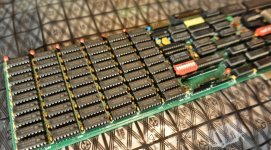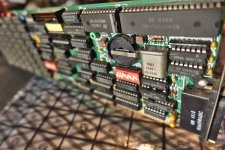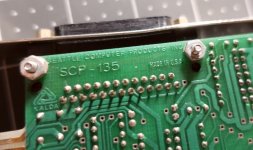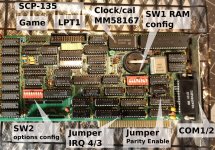chris_nh
Experienced Member
Hi everyone, I am taking a look at this rare board, a Seattle Computer Products "RAM+6" multifunction board, offering 384k of RAM, RS-232 port, parallel port, game port and battery backed clock.
Seattle Computer Products "Ram+6" or "RAM Plus 6"
Model: SCP-135





The functions of this board are essentially standard for most multifunction boards of the early 80's PC era. The SCP-135 w/ 384k cost $485 in 1984 dollars, and the game port was not included, but available as another $25 add-on. The DB25 serial port is on the card bracket, while the parallel port attached via a ribbon cable to a header on the top of the board.
One very nice feature of SCP products is that all of the ICs are socketed rather than soldered to the board. This makes the card very serviceable by the end user should any chip malfunction.
This board would sit there right along with the other similar multifunction boards in the pack, but it is far less common than the AST SixPak or even the Quadram Quadboard series. I doubt Seattle Computer Products sold many of these boards, which today has resulted in a near complete lack of documentation and software available in the modern era for these old lost Seattle Computer boards. I consider the lack of documentation part of the mystery, and that somebody somewhere has the documentation and software and it may eventually will find a way out into the vintage computer community.
However, for now without any documentation, I sorted out most of the DIP switch settings. The SCP-135 has 2 8-position switch blocks. SW1 is just beneath the battery holder, closer to the bracket end of the board. SW2 is adjacent to the RAM banks. Contrary to what a first glance may imply, SW2 which is situated next to the RAM actually configures the other features of the card. SW1 configures the RAM.
The switch settings are not fully decoded yet, but I'll share what I have found so far, just for anyone in the future who might need them:
SW1/1: RAM base address A15
SW1/2: RAM base address A16
SW1/3: RAM base address A17
SW1/4: RAM base address A18
SW1/5: RAM base address A19
SW1/6: RAM bank enable low bit (1)
SW1/7: RAM bank enable bit (2)
SW1/8: RAM bank enable high bit (4)
Description of SW1 base address: The first 5 bits select the base address of the card by selecting address lines. For example, the place the card at the 256k base address to extend the ram on a 256k motherboard, A18 SW1/4 is turned on. To place the card at the 64k base, such as a 64k 5150 motherboard, A16 SW1/2 is turned on. To place the card at 512k base, such as filling 128k to make 640k, A19 SW1/5 is turned on. It appears that the base addressing of A15-A19 would allow for the card to be placed on any 32k boundary, possibly from 0k or 16k base if all switches are off (more testing needed to confirm 16k base). Chips on board are 64k types, so normally would only need 64k boundaries, but the 32k boundaries give a lot more flexibility.
Description of SW1 bank enable: The setting is a binary value, with the lowest order bit on the left. All off (zero), only the first bank is enabled. The first bank is always enabled. For 0k RAM configuration, chips must be removed. For 64k configuration, first bank would be populated. Then, we would use the switches to add number of banks. So, for 2 banks, we add 1 by setting the 6-7-8 switches to On-off-off. For 3 banks, we add 2 by setting the 6-7-8 switches to off-on-off.
Bank enable chart, switches 6,7,8 (1=on, 0=off)
0 or 1 bank installed: 0 0 0
2 banks installed: 1 0 0
3 banks installed: 0 1 0
4 banks installed: 1 1 0
5 banks installed: 0 0 1
6 banks installed: 1 0 1
Also possible are the binary values for 7 and 8 banks, but the card maxes out at 6 banks and still only presents 384k (6 banks) to the system.
Now, for the switches for other functions:
SW2/1: Serial Port IO 3F8/2F8
SW2/2: Serial enable/disable
SW2/3: Unknown, off=no boot
SW2/4: LPT1 IO 378/3BC
SW2/5: Unsure, possible game port IO
SW2/6: Unsure, possible game port IO
SW2/7: Unsure, possible game port IO
SW2/8: Off= boot error 6098 201 (IBM 5150)
Jumper near parallel port: Ram Parity enable
Jumper near card edge: Serial port IRQ4/3 select
Real Time Clock function - MM58167AN chip
Of course Marty, check the clock ... well, the clock on this card remains unresolved. The MM58167 chip is a common one, so no mystery there, except that every board maker used different IO ports for where the clock chip is located. Some manufacturers even hid the chip behind a set of interface registers like the Tecmar Captain board. So far, the hunt for the clock IO port on this SCP-135 board is still ongoing. I have not found it yet ... I've tried the excellent "CLOCK.COM" program found here in the Vcfed forums to try and detect this clock, but not found. I have tried varying switch settings. I wrote a utility to dump all IO ports out to data files and used the dumps to hunt for the IO ports through several methods and possibilities, and looked at every IO port I could find, yet no clock. I did confirm the clock chip is good by swapping it to another board, so the quest to find the clock IO for this board will continue!
Seattle Computer Products was a better known in the S-100 world, but their history and contributions to the development of the IBM PC is undeniable. I always wonder why they weren't more successful at selling the PC add-ons, as they were the first to ever produce a 3rd party memory add-on board for the IBM PC, but SCP owner Rod Brock is once quoted in a comment about offshore competition "were selling memory boards for less than his cost for parts". This ultimately lead to the end of the company around 1985.
Seattle Computer Products other PC boards:
SCP-130 "Ram +" - This was their first RAM add-on board for the PC, designed by Tim Patterson. Here is an earlier forum post about it: http://www.vcfed.org/forum/showthre...roducts-ram-board-looking-for-switch-settings
RAM +3 - this board was announced sometime around October 1983, it offered 256K of RAM, RS-232 and Parallel ports, plus software. https://books.google.com/books?id=q...nepage&q=pc magazine seattle ram plus&f=false
RAM +6 - The SCP-135 covered here in this post, it offered up to 384k RAM, RS-232, parallel, game and clock plus software. https://books.google.com/books?id=D...seattle computer ram 6 multi function&f=false
Ram +6 ad: https://books.google.com/books?id=0..."seattle computer products" ram clock&f=false
RAM 7 - The October 29, 2985 issue of PC Magazine announces a new SCP board called "RAM 7", but little info is known about this board or if SCP ever produced it, but it appears to be a "dual-function" board with up to 384k RAM and clock chip. https://books.google.com/books?id=j...gazine seattle computer products 384k&f=false
I hope you've enjoyed this little look at Seattle Computer Products PC boards, and I'm always hopeful that somebody will dig up the documentation and software for Seattle Computer Products. I even found USENET posts from 1991 where someone was looking for the software back then It has to be somewhere and I know someone will find it and share it! Haha, thanks for reading.
It has to be somewhere and I know someone will find it and share it! Haha, thanks for reading.
Seattle Computer Products "Ram+6" or "RAM Plus 6"
Model: SCP-135





The functions of this board are essentially standard for most multifunction boards of the early 80's PC era. The SCP-135 w/ 384k cost $485 in 1984 dollars, and the game port was not included, but available as another $25 add-on. The DB25 serial port is on the card bracket, while the parallel port attached via a ribbon cable to a header on the top of the board.
One very nice feature of SCP products is that all of the ICs are socketed rather than soldered to the board. This makes the card very serviceable by the end user should any chip malfunction.
This board would sit there right along with the other similar multifunction boards in the pack, but it is far less common than the AST SixPak or even the Quadram Quadboard series. I doubt Seattle Computer Products sold many of these boards, which today has resulted in a near complete lack of documentation and software available in the modern era for these old lost Seattle Computer boards. I consider the lack of documentation part of the mystery, and that somebody somewhere has the documentation and software and it may eventually will find a way out into the vintage computer community.
However, for now without any documentation, I sorted out most of the DIP switch settings. The SCP-135 has 2 8-position switch blocks. SW1 is just beneath the battery holder, closer to the bracket end of the board. SW2 is adjacent to the RAM banks. Contrary to what a first glance may imply, SW2 which is situated next to the RAM actually configures the other features of the card. SW1 configures the RAM.
The switch settings are not fully decoded yet, but I'll share what I have found so far, just for anyone in the future who might need them:
SW1/1: RAM base address A15
SW1/2: RAM base address A16
SW1/3: RAM base address A17
SW1/4: RAM base address A18
SW1/5: RAM base address A19
SW1/6: RAM bank enable low bit (1)
SW1/7: RAM bank enable bit (2)
SW1/8: RAM bank enable high bit (4)
Description of SW1 base address: The first 5 bits select the base address of the card by selecting address lines. For example, the place the card at the 256k base address to extend the ram on a 256k motherboard, A18 SW1/4 is turned on. To place the card at the 64k base, such as a 64k 5150 motherboard, A16 SW1/2 is turned on. To place the card at 512k base, such as filling 128k to make 640k, A19 SW1/5 is turned on. It appears that the base addressing of A15-A19 would allow for the card to be placed on any 32k boundary, possibly from 0k or 16k base if all switches are off (more testing needed to confirm 16k base). Chips on board are 64k types, so normally would only need 64k boundaries, but the 32k boundaries give a lot more flexibility.
Description of SW1 bank enable: The setting is a binary value, with the lowest order bit on the left. All off (zero), only the first bank is enabled. The first bank is always enabled. For 0k RAM configuration, chips must be removed. For 64k configuration, first bank would be populated. Then, we would use the switches to add number of banks. So, for 2 banks, we add 1 by setting the 6-7-8 switches to On-off-off. For 3 banks, we add 2 by setting the 6-7-8 switches to off-on-off.
Bank enable chart, switches 6,7,8 (1=on, 0=off)
0 or 1 bank installed: 0 0 0
2 banks installed: 1 0 0
3 banks installed: 0 1 0
4 banks installed: 1 1 0
5 banks installed: 0 0 1
6 banks installed: 1 0 1
Also possible are the binary values for 7 and 8 banks, but the card maxes out at 6 banks and still only presents 384k (6 banks) to the system.
Now, for the switches for other functions:
SW2/1: Serial Port IO 3F8/2F8
SW2/2: Serial enable/disable
SW2/3: Unknown, off=no boot
SW2/4: LPT1 IO 378/3BC
SW2/5: Unsure, possible game port IO
SW2/6: Unsure, possible game port IO
SW2/7: Unsure, possible game port IO
SW2/8: Off= boot error 6098 201 (IBM 5150)
Jumper near parallel port: Ram Parity enable
Jumper near card edge: Serial port IRQ4/3 select
Real Time Clock function - MM58167AN chip
Of course Marty, check the clock ... well, the clock on this card remains unresolved. The MM58167 chip is a common one, so no mystery there, except that every board maker used different IO ports for where the clock chip is located. Some manufacturers even hid the chip behind a set of interface registers like the Tecmar Captain board. So far, the hunt for the clock IO port on this SCP-135 board is still ongoing. I have not found it yet ... I've tried the excellent "CLOCK.COM" program found here in the Vcfed forums to try and detect this clock, but not found. I have tried varying switch settings. I wrote a utility to dump all IO ports out to data files and used the dumps to hunt for the IO ports through several methods and possibilities, and looked at every IO port I could find, yet no clock. I did confirm the clock chip is good by swapping it to another board, so the quest to find the clock IO for this board will continue!
Seattle Computer Products was a better known in the S-100 world, but their history and contributions to the development of the IBM PC is undeniable. I always wonder why they weren't more successful at selling the PC add-ons, as they were the first to ever produce a 3rd party memory add-on board for the IBM PC, but SCP owner Rod Brock is once quoted in a comment about offshore competition "were selling memory boards for less than his cost for parts". This ultimately lead to the end of the company around 1985.
Seattle Computer Products other PC boards:
SCP-130 "Ram +" - This was their first RAM add-on board for the PC, designed by Tim Patterson. Here is an earlier forum post about it: http://www.vcfed.org/forum/showthre...roducts-ram-board-looking-for-switch-settings
RAM +3 - this board was announced sometime around October 1983, it offered 256K of RAM, RS-232 and Parallel ports, plus software. https://books.google.com/books?id=q...nepage&q=pc magazine seattle ram plus&f=false
RAM +6 - The SCP-135 covered here in this post, it offered up to 384k RAM, RS-232, parallel, game and clock plus software. https://books.google.com/books?id=D...seattle computer ram 6 multi function&f=false
Ram +6 ad: https://books.google.com/books?id=0..."seattle computer products" ram clock&f=false
RAM 7 - The October 29, 2985 issue of PC Magazine announces a new SCP board called "RAM 7", but little info is known about this board or if SCP ever produced it, but it appears to be a "dual-function" board with up to 384k RAM and clock chip. https://books.google.com/books?id=j...gazine seattle computer products 384k&f=false
I hope you've enjoyed this little look at Seattle Computer Products PC boards, and I'm always hopeful that somebody will dig up the documentation and software for Seattle Computer Products. I even found USENET posts from 1991 where someone was looking for the software back then

